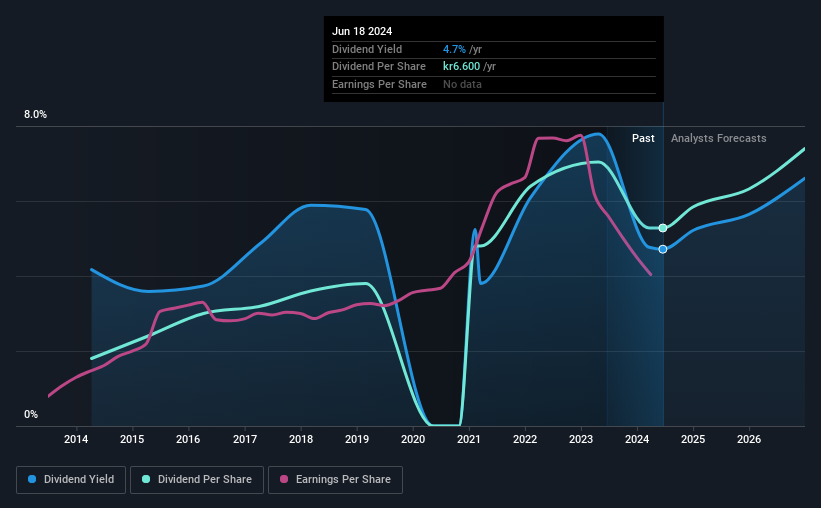
The board of Bilia AB (publ) (STO:BILI A) has announced that it will pay a dividend on the 11th of July, with investors receiving SEK1.65 per share. This means that the annual payment will be 4.7% of the current stock price, which is in line with the average for the industry.
View our latest analysis for Bilia
Bilia's Dividend Is Well Covered By Earnings
While it is always good to see a solid dividend yield, we should also consider whether the payment is feasible. Before making this announcement, Bilia was paying out quite a large proportion of both earnings and cash flow, with the dividend being 519% of cash flows. Paying out such a high proportion of cash flows certainly exposes the company to cutting the dividend if cash flows were to reduce.
Over the next year, EPS is forecast to expand by 52.9%. If the dividend continues along recent trends, we estimate the payout ratio will be 62%, which is in the range that makes us comfortable with the sustainability of the dividend.

Dividend Volatility
While the company has been paying a dividend for a long time, it has cut the dividend at least once in the last 10 years. Since 2014, the annual payment back then was SEK2.25, compared to the most recent full-year payment of SEK6.60. This implies that the company grew its distributions at a yearly rate of about 11% over that duration. It is great to see strong growth in the dividend payments, but cuts are concerning as it may indicate the payout policy is too ambitious.
Dividend Growth May Be Hard To Achieve
With a relatively unstable dividend, it's even more important to evaluate if earnings per share is growing, which could point to a growing dividend in the future. However, Bilia has only grown its earnings per share at 4.3% per annum over the past five years. Slow growth and a high payout ratio could mean that Bilia has maxed out the amount that it has been able to pay to shareholders. When the rate of return on reinvestment opportunities falls below a certain minimum level, companies often elect to pay a larger dividend instead. This is why many mature companies often have larger dividend yields.
In Summary
In summary, dividends being cut isn't ideal, however it can bring the payment into a more sustainable range. While Bilia is earning enough to cover the payments, the cash flows are lacking. We don't think Bilia is a great stock to add to your portfolio if income is your focus.
Market movements attest to how highly valued a consistent dividend policy is compared to one which is more unpredictable. However, there are other things to consider for investors when analysing stock performance. For example, we've picked out 3 warning signs for Bilia that investors should know about before committing capital to this stock. Is Bilia not quite the opportunity you were looking for? Why not check out our selection of top dividend stocks.
If you're looking to trade Bilia, open an account with the lowest-cost platform trusted by professionals, Interactive Brokers.
With clients in over 200 countries and territories, and access to 160 markets, IBKR lets you trade stocks, options, futures, forex, bonds and funds from a single integrated account.
Enjoy no hidden fees, no account minimums, and FX conversion rates as low as 0.03%, far better than what most brokers offer.
Sponsored ContentValuation is complex, but we're here to simplify it.
Discover if Bilia might be undervalued or overvalued with our detailed analysis, featuring fair value estimates, potential risks, dividends, insider trades, and its financial condition.
Access Free AnalysisHave feedback on this article? Concerned about the content? Get in touch with us directly. Alternatively, email editorial-team (at) simplywallst.com.
This article by Simply Wall St is general in nature. We provide commentary based on historical data and analyst forecasts only using an unbiased methodology and our articles are not intended to be financial advice. It does not constitute a recommendation to buy or sell any stock, and does not take account of your objectives, or your financial situation. We aim to bring you long-term focused analysis driven by fundamental data. Note that our analysis may not factor in the latest price-sensitive company announcements or qualitative material. Simply Wall St has no position in any stocks mentioned.
Have feedback on this article? Concerned about the content? Get in touch with us directly. Alternatively, email editorial-team@simplywallst.com
About OM:BILI A
Bilia
Operates as a full-service supplier for car ownership in Sweden, Norway, Luxemburg, and Belgium.
Undervalued with adequate balance sheet and pays a dividend.
Market Insights
Community Narratives



